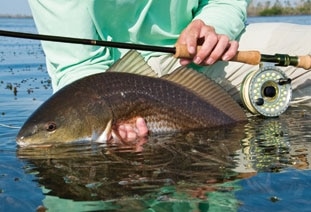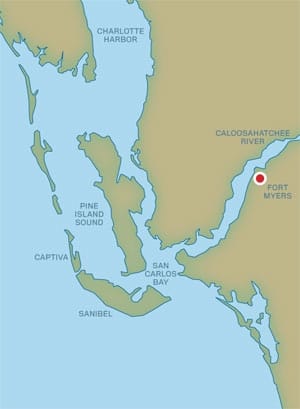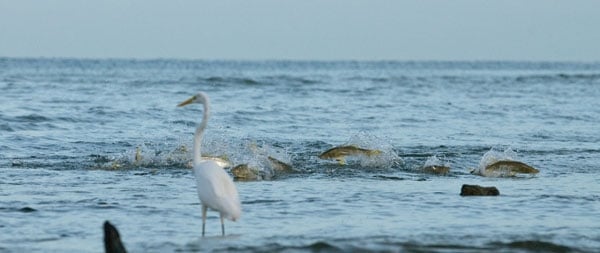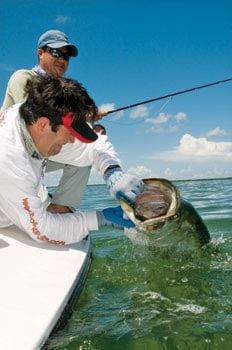
|| |—| | Photo by Rick DePavia| The wind was howling out of the north that cold October morning, pushing whitecaps over the vast open-water flats of San Carlos Bay. The first front of fall had just moved through southwest Florida, and I clutched at my hat while straining to see beneath the chop.
Capt. Rick De Paiva and I already had spotted a few nice reds that morning, but the persistent 25-knot gusts had made casting a challenge, to say the least. So we picked up and pointed the skiff toward nearby Pine Island Sound, where we hoped to find protection.
Sure enough, we found it in short order. Rick poled me back into a skinny creek that was simply bustling with activity, full of mullet and catfish. The creek was surrounded by a canopy of wind-breaking mangroves, and as we came around a corner, a dark shape suddenly materialized over the orange bottom. No catfish there!
I quickly placed one of Rick’s Merkwan flies just in front of the big red drum, and two strips later, the offering was devoured in a puff of sand.
Coming tight to that fish felt wonderful on that blustery morning, and the thick red put up a dogged fight in the close quarters, twice nearly getting me into the mangrove shoots. But finally it came alongside, and as I released it back into the tannin-stained water, I simply had to smile.
There are never any guarantees in this sport, but no matter the weather or time of year, there’s usually something good to be found around Fort Myers and Cape Coral. It rarely fails.
Glowing Wintertime Reds
Located south of Tampa and north of Chokoloskee on Florida’s Gulf Coast, the Fort Myers region is perhaps most famous for its shelling and bird-watching on nearby Sanibel and Captiva islands. But this area offers fly-anglers terrific year-round opportunities as well.

Fed directly by the Caloosahatchee River and bordered to the north by Charlotte Harbor and the Peace and Myakka rivers, the waterways around Fort Myers are intricate and diverse. San Carlos Bay and Matlacha Pass comprise the inner fishing zones, abutting the Florida mainland, while Pine Island Sound lies just to their west, residing between a group ofbarrier islands, including Captiva and Sanibel. Outside these barrier islands spans the open Gulf of Mexico.
Rich grass flats, deep channels and dense mangrove estuary systems abound inshore here, while the Gulf beaches lie directly in the path of Florida’s springtime tarpon migrations. It all adds up to a wonderful mix of ingredients for some of the Sunshine State’s favorite fly-rodding species – and while redfish are the primary target, they’re certainly not alone. Tarpon, snook, tripletail, sea trout, cobia and various other species are commonly caught here as well. Best of all, because these species’ primary seasons are dispersed throughout the year, an angler is usually never lacking for action.
It’s no surprise that my recent trip in October revolved primarily around redfish. They flourish in these waters all year long but are particularly active from late October until March. During these colder months, negative tides – or lower-than-average water levels – occur regularly during the daytime hours, exposing large areas of flats that normally might not be fishable. These abnormal tides congregate the reds and also make it much easier to spot them in the shallows.
“As long as the wind is not blowing, those superlow tides are a great time to be sight-casting,” says Capt. Paul Hobby, a Fort Myers native and 17-year guide in this area. “It pulls the reds out of the trees, so they can’t hide and they’re forced to feed in the open. You can spend the whole day in a foot or two feet of water, and if you get sunlight, it can be sight-casting all day long.”
Twenty to 30 shots per day at tailing reds are fairly typical under benign conditions this time of year, Hobby says, and they’ll readily eat an accurately placed crab fly on an 8- or 9-weight outfit.
There’s no mistaking these fish – they vividly appear as bright orange blotches, and De Paiva jokingly refers to several of his favorite flats as “pumpkin patches,” with the reds showing like big orange pumpkins over the wavering green grass.
While it certainly helps to have mild winds for the pumpkin-patch reds this time of year, it’s imperative when heading offshore. But it’s something to consider, as Florida’s stone crab season runs from mid-October to mid-May. During this time, hundreds of crab pots are placed just off the beaches in the Gulf, attracting tripletail.
De Paiva has caught them up to 16 pounds on these structures. He generally looks for older pots with vegetation growth and then tosses shrimp or baitfish patterns to the fish on either floating or sink-tip lines. His best day on fly? Twenty-nine fish. “It was just ridiculous,” he recalls.

Photo by David McCleaf
Springtime Awakenings
That particular day was in late April, one of De Paiva’s favorite times to fish for these strange critters. In fact, the whole area starts to light up in spring. The redfishing isn’t great in March and April, but it becomes prime time for snook and tarpon, in addition to the tripletail.
The action begins in the backcountry. As the water warms to about 68 to 70 degrees, the snook begin moving out of their wintering positions in deep- water holes and channels in the Caloosahatchee and throughout Pine Island Sound. They are aggressive and hungry.
“They start migrating toward the mouth of the river, where they’ll find bait,” De Paiva says. “It’s the best time of year to sight-cast them. We saw some fish last year in the 20- to 25-pound range. They didn’t eat, but our hearts were going crazy! It’s all over white-sand bottom, within a foot or two of water.”
De Paiva typically uses 8- or 9-weight outfits with floating lines and either red-and-white Seaducers with tiny red eyes or Puglisi streamers, such as the Everglades Special.
Sight-casting snook on the flats is no easy game, though. They’re always tough, even during the springtime. But there is no better chance to get one. What’s more, as April kicks in and the water continues to warm to 75 degrees or so, the area’s resident tarpon begin appearing in the backwaters too.
“Most are residential fish coming out of the Caloosahatchee,” De Paiva says. “They lay up in the backcountry, and they are pretty good-sized residents, 75 to 120 pounds. They’re like black logs, just sitting there floating. On a good day, it’s typical to see a dozen to two dozen laid-up fish, and because they haven’t seen much yet coming out of the river, they usually eat all the standard tarpon flies really well.”
Things only get better as the springtime turns into summer. The migratory tarpon begin pushing through the area, typically showing up around Knapps Point off Sanibel in mid-April and then building in numbers over the course of the next month. By mid-May, the outside Gulf fishery can be on fire, with thousands of tarpon schooling and daisy-chaining near the surface in roughly 20 feet of water. They are moving north toward Boca Grande Pass.
“There are a lot of places to intercept them off Sanibel, Captiva and Caya Costa, and a lot of room for boats,” Hobby says. “That’s good, because no one likes to fish around crowds.”
Driven by the urge to spawn, the snook eventually take to the beaches as well. Unlike the tarpon, however (which generally amass one to three miles off the coast), the linesiders cruise just along the sandy beach.
This presents a great opportunity for stalking fish by foot on Sanibel and Captiva. In fact, wading the beaches is much preferred over fishing for them from a boat. The fish are generally small males traveling in packs of four or five, but lone females upwards of 40 inches can also be encountered. When you see a fish, cast a Clouser Minnow or other small baitfish pattern well ahead of your target so it doesn’t spook. Let the fly sink, and then work it as the fish approaches.
These fish usually stick very close to where the water meets the sand, and they are spooky in the clear Gulf water. For that reason, “If your feet are wet, you’re fishing them wrong!” De Paiva says. “And don’t forget to watch for egrets. They will usually be near a pod of minnows, and you can often see the snook around the minnows too.”
Transition Months of Fall
The migratory tarpon and snook action begins to taper off in late summer or early fall, but as the weather cools, the snook can again be intercepted on the flats as they move back into their wintering backcountry holes.
It can be a brief (and sometimes very challenging) bite. But an easier scenario is available in the wee hours of night around the many lighted docks and bridges of the area. This fishery peaks in summertime, but it’s truly year-round and a blast on an 8-weight with small shrimp or minnow imitations. In fact, De Paiva says that during his 11 years guiding in this area, his clients have never been skunked fly-rodding snook around the docks.
“I don’t care how cold or windy it is, we always hook fish,” he says. “I’ve caught them in water temps of 58½ degrees! It’s really a neat fishery. They are on the feed at night.”
Other species are on the feed as well during the fall, and De Paiva describes October as a transition month and one of his favorite times to fish.
Big pushes of bait, including glass minnows and scaled sardines, start migrating to warmer southern waters just off the beaches, and a host of hungry predators are usually hot on their tail. Tarpon, Spanish mackerel, little tunny, jack crevalle and big sharks can often be seen crashing with reckless abandon into this bait, providing a perfect opportunity to score a mixed bag on fly.
The redfishing begins to pick up again too. As the tides revert back into their negative wintertime patterns, the resident fish start showing again on all the area’s flats – and quite often they can be found hovering just behind southern stingrays, which move into the area and glide silently over the grassy flats, kicking up crabs and shrimp along the way.
Another group of reds also pushes into the inshore waters this time of year. These fish are different from the residents. They amass in much larger schools and can often be found in open, deeper inshore waters.
The fish, which De Paiva and Hobby believe move in from the Gulf, are somewhat larger in size and travel in packs upwards of 100. They’ll get on the flats occasionally, but often can be found near the surface in four to five feet of water. They also move agressively on properly placed flies most times.
Toggling back and forth between the skittish tailers and the open-water roamers can make for a fun outing enjoyed equally by novice and experienced fly-fishermen alike.
And all the while, wise guides remain vigilant this time of year running to and from spots. On more than one occasion, Hobby’s come across a fat tripletail or a big cobia hanging around the many channel markers that dot these waterways.
These fish will gobble up a fly. And for that reason, you should always be prepared with a larger rod – a theme that’s quite common around Fort Myers.
“It always seems like there’s something to fill in the gaps,” Hobby says. “No matter the time of year, and even if the weather is nasty, there’s never a void.”
No, there’s usually not. And that’s a big part of what makes this area special.

Photo by David McCleaf| Not only does Fort Myers have great year-round fishing, but it’s convenient. Southwest Florida International Airport (RSW) lies just east of town and is only a short drive from the coast. There, anglers will find two excellent lodging options in close proximity to the popular Punta Rassa boat ramp: the Country Inn & Suites and the Sanibel Harbour Resort & Spa.
The latter offers a more upscale experience, but I stayed at the Country Inn during my trip and found it perfectly comfortable, with Internet access and continental breakfast.
For additional lodging information, contact:
- Country Inn & Suites – 239-454-9292; www.countryinns.com/sanibelfl_gateway
- Sanibel Harbour Resort & Spa – 239-466-4000; www.sanibel-resort.com
- Tarpon Lodge – 239-283-3999; www.tarponlodge.com
To book a charter, contact:
- Capt. Rick De Paiva – 239-246-8726; www.saltwaterflyfishing.org
- Capt. Paul Hobby – 239-433-1007; www.fishinghobby.com
For more information on Fort Myers, visit:
- Lee County Visitor & Convention Bureau – 239-338-3500; www.fortmyers-sanibel.com
What to Use:
RODS: 8- or 9-weight for redfish, snook, tripletail and Spanish mackerel; 11- or 12-weight for tarpon and cobia.
REELS: Any of the reputable brands, such as Tibor orIslander, that have smooth drags and large-arbor designs.
LINES: Weight-forward floaters work well universally around Fort Myers, especially for shallow-water redfish and snook. An intermediate sink tip will also work when the fish are a little deeper or when targeting tarpon, tripletail, grouper, cobia and other beach cruisers.
LEADERS: 10-footers tapered down to 10-, 12- and 16-pound tippets will work in most situations. Be sure to bring 25- and 30-pound fluorocarbon material for snook shock leaders, along with 60-pound material for tarpon.
FLIES: For redfish, a black Seaducer with a bunny or arctic fox tail in No. 2 or 4 will work, as will small crab patterns; the Merkwan – a combo between a Merkin and a Dorsey’s Kwan – is also a very good pattern here. Snook can be had on red-and-white Seaducers, Puglisi-type streamers, Clousers and Rivets in No. 2 and 4. For tarpon, try any of the traditional Keys patterns, along with Toads and Puglisi streamers.
OTHER: Be sure to bring all the usual items for flats fishing, such as high-quality polarized glasses and a good hat. Bring a healthy appetite as well – there are lots of fine restaurants in this area









